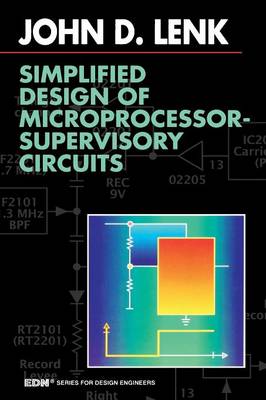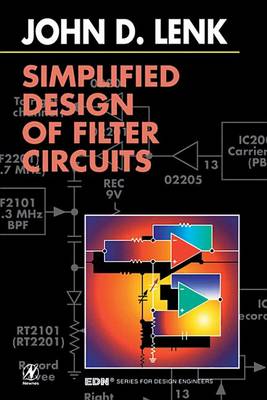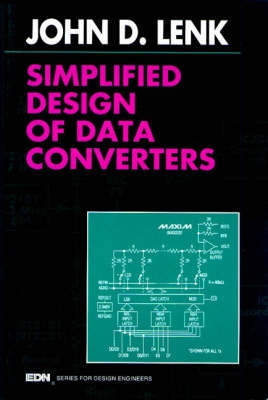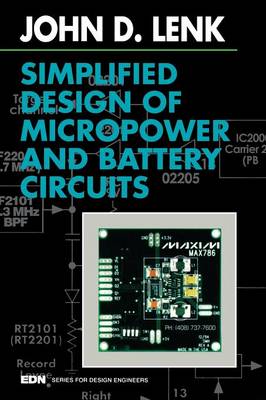EDN Series for Design Engineers
7 total works
Simplified Design of Switching Power Supplies is an all-inclusive, one-stop guide to switching power-supply design. Step-by-step instructions and diagrams render this book essential for the student and the experimenter, as well as the design professional.
Simplified Design of Switching Power Supplies concentrates on the use of IC regulators. All popular forms of switching supplies, including DC-DC converters, inverters, buck, boost, buck-boost, pulse frequency modulation, pulse width modulation, current-mode control and pulse skipping, are described in detail. The design examples may be put to immediate use or may be modified to meet a specific design goal. As an instructional text for those unfamiliar with switching supplies, or as a reference for those in need of a refresher, this unique book is essential for those involved in switching power-supply design.
Simplified Design of Switching Power Supplies concentrates on the use of IC regulators. All popular forms of switching supplies, including DC-DC converters, inverters, buck, boost, buck-boost, pulse frequency modulation, pulse width modulation, current-mode control and pulse skipping, are described in detail. The design examples may be put to immediate use or may be modified to meet a specific design goal. As an instructional text for those unfamiliar with switching supplies, or as a reference for those in need of a refresher, this unique book is essential for those involved in switching power-supply design.
Simplified Design of IC Amplifiers has something for everyone involved in electronics. No matter what skill level, this book shows how to design and experiment with IC amplifiers. For experimenters, students, and serious hobbyists, this book provides sufficient information to design and build IC amplifier circuits from 'scratch'. For working engineers who design amplifier circuits or select IC amplifiers, the book provides a variety of circuit configurations to make designing easier.
This is the seventh book in the popular Simplified Design series from John Lenk, which teaches engineers, technicians, and students to use and modify off-the-shelf ICs to suit their individual design needs.
The first chapter of this book describes the basic operation of microprocessor supervisory circuits and how to use manufacturer data sheets to make your component selections. Later chapters describe the internal operations of various commonly-available ICs and how to select and modify them.
The most common microprocessor-supervisory functions include: power-on reset, low-voltage reset for glitch and brownout, memory-write protection, power-fail warning, battery backup switchover, and watchdog timer. While these functions are not difficult to implement individually, they can be complex in combination, particularly when there are space limitations. Simplified Design of Microprocessor-Supervisory Circuits will allow designers to evaluate tradeoffs and features more easily and quickly.
The first chapter of this book describes the basic operation of microprocessor supervisory circuits and how to use manufacturer data sheets to make your component selections. Later chapters describe the internal operations of various commonly-available ICs and how to select and modify them.
The most common microprocessor-supervisory functions include: power-on reset, low-voltage reset for glitch and brownout, memory-write protection, power-fail warning, battery backup switchover, and watchdog timer. While these functions are not difficult to implement individually, they can be complex in combination, particularly when there are space limitations. Simplified Design of Microprocessor-Supervisory Circuits will allow designers to evaluate tradeoffs and features more easily and quickly.
Simplified Design of Filter Circuits, the eighth book in this popular series, is a step-by-step guide to designing filters using off-the-shelf ICs. The book starts with the basic operating principles of filters and common applications, then moves on to describe how to design circuits by using and modifying chips available on the market today. Lenk's emphasis is on practical, simplified approaches to solving design problems.
Simplified Design of V/F Converters shows how to design and experiment with V/F converters, both voltage-to-frequency and frequency-to-voltage. The design approach here is the same one used in all of John Lenk's best-selling books on simplified and practical design. Throughout the book, design problems start with guidelines for selecting all components on a trial-value basis, assuming a specific design goal and set of conditions. Then, using the guideline values in experimental circuits, the desired results are produced by varying the experimental component values, if needed.
If you are a working engineer responsible for designing VFCs, or selecting IC converters, the variety of circuit configurations described here should simplify your task. Not only does the book describe converter-circuit designs, but it also covers the most popular forms of VFC ICs available. Throughout the book, you will find a wealth of information on VFC ICs and related components, including how to test and troubleshoot completed circuits.
If you are a working engineer responsible for designing VFCs, or selecting IC converters, the variety of circuit configurations described here should simplify your task. Not only does the book describe converter-circuit designs, but it also covers the most popular forms of VFC ICs available. Throughout the book, you will find a wealth of information on VFC ICs and related components, including how to test and troubleshoot completed circuits.
Simplified Design of Data Converters shows how to design and experiment with data converters, both analog-to-digital and digital to analog. The design approach here is the same one used in all of John Lenk's best-selling books on simplified and practical design. Throughout the book, design problems start with guidelines for selecting all components on a trial-value basis, assuming a specific design goal and set of conditions. Then, using the guideline values in experimental circuits, the desired results are produced by varying the experimental component values, if needed.
If you are a working engineer responsible for designing data-converters circuits, or selecting IC data converters, the variety of circuit configurations described here should generally simplify your task. Not only does the book describe converter-circuit designs, but it also covers the most popular forms of data-converter ICs available. Throughout the book, you will find a wealth of information on data-converter ICs and related components.
If you are a working engineer responsible for designing data-converters circuits, or selecting IC data converters, the variety of circuit configurations described here should generally simplify your task. Not only does the book describe converter-circuit designs, but it also covers the most popular forms of data-converter ICs available. Throughout the book, you will find a wealth of information on data-converter ICs and related components.
Simplified Design of Micropower and Battery Circuits provides a simplified, step-by-step approach to micropower and supply cell circuit design. No previous experience in design is required to use the techniques described, thus making the book well suited for the beginner, student, or experimenter as well as the design professional.
Simplified Design of Micropower and Battery Circuits concentrates on the use of commercial micropower ICs by discussing selections of external components that modify the IC-package characteristics. The basic approach is to start design problems with approximations for trial-value components in experimental circuits, then to vary the component values until the desired results are produced. Although theory and mathematics are kept to a minimum, operation of all circuits is described in full.
EDITOR'S CHOICE - Electronics (The Maplin Magazine), May 1996 John D. Lenk has been a technical author specializing in practical electronic design and troubleshooting guides for more than 40 years. An established writer of international best-sellers in the field of electronics, Mr. Lenk is the author of more than 80 books on electronics, which together have sold well over two million copies in nine languages.
Simplified Design of Micropower and Battery Circuits concentrates on the use of commercial micropower ICs by discussing selections of external components that modify the IC-package characteristics. The basic approach is to start design problems with approximations for trial-value components in experimental circuits, then to vary the component values until the desired results are produced. Although theory and mathematics are kept to a minimum, operation of all circuits is described in full.
EDITOR'S CHOICE - Electronics (The Maplin Magazine), May 1996 John D. Lenk has been a technical author specializing in practical electronic design and troubleshooting guides for more than 40 years. An established writer of international best-sellers in the field of electronics, Mr. Lenk is the author of more than 80 books on electronics, which together have sold well over two million copies in nine languages.





